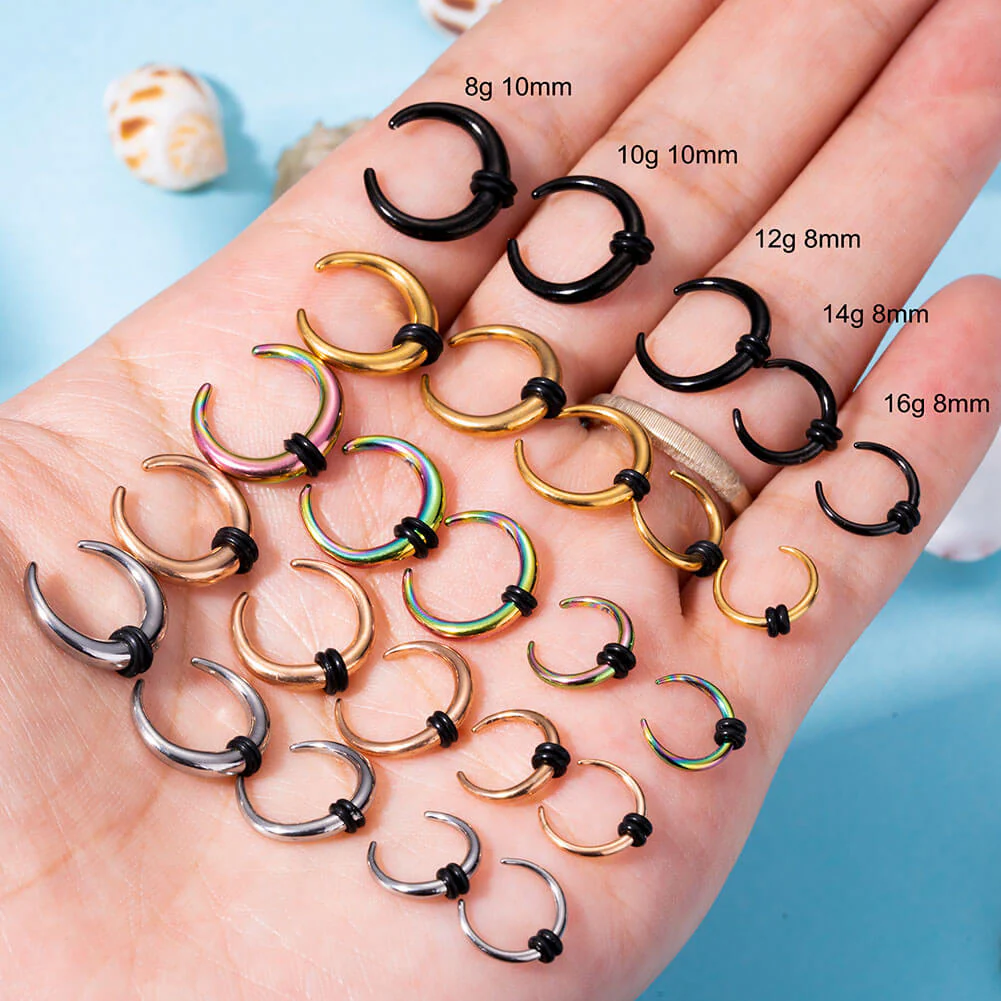What Gauge is a Septum Piercing?
A septum piercing is a type of nose piercing that goes through the septum, the piece of cartilage that separates the nostrils. While the exact gauge used can vary, the industry standard for septum piercings is typically 16 gauge (16g) or 1.2 millimeters thick.
Standard Septum Piercing Gauge
The most common gauge used for septum piercings is 16g, which is the same size used for lobe piercings. However, some piercers may use an 18 gauge (18g) or 1 millimeter needle for a smaller piercing.After the initial piercing, some people choose to size up or down depending on their preference. Septum piercings can be stretched to a 14 gauge (14g) for a larger look, while sizing down to an 18g is an option for a more delicate appearance.
Understanding Septum Piercing Jewelry
Once you have your septum piercing, choosing the right jewelry is essential for comfort, healing, and style. The type of jewelry you select can also influence the look of your piercing and how it heals. Here’s a closer look at the different types of jewelry available for septum piercings.
Types of Septum Jewelry
- Captive Bead Rings (CBRs)
- Description: Captive bead rings consist of a circular ring with a bead that is held in place by the tension of the ring. They are a popular choice for septum piercings due to their classic look and ease of use.
- Material: Typically made from surgical steel, titanium, or bio-compatible materials.
- Pros: Easy to insert and remove; available in various sizes and colors.
- Cons: The bead can be uncomfortable for some wearers.
- Circular Barbells
- Description: Similar to captive bead rings, circular barbells have a curved shape with two ends that can be adorned with beads or other decorative elements.
- Material: Often made from stainless steel, titanium, or acrylic.
- Pros: Allows for more decorative options; can be more comfortable than CBRs.
- Cons: May require more effort to insert due to the curved shape.
- Septum Clickers
- Description: Clickers are hinged rings that can be opened and closed easily. They often have decorative elements that make them stand out.
- Material: Commonly made from stainless steel, gold, or other metals.
- Pros: Easy to wear and remove; available in various designs and styles.
- Cons: Can be more expensive than other options.
- Septum Retainers
- Description: These are designed for those who want to hide their piercing. They are often clear or made from flexible materials.
- Material: Usually made from acrylic or bioplast.
- Pros: Ideal for work or school environments where visible piercings are not allowed.
- Cons: Limited aesthetic appeal; not suitable for long-term wear.
Choosing the Right Material
When selecting jewelry for your septum piercing, the material is just as important as the style. Here are some common materials used for septum jewelry:
- Surgical Stainless Steel: A popular choice due to its durability and resistance to corrosion. It’s also hypoallergenic for most individuals.
- Titanium: Known for being lightweight and strong, titanium is an excellent choice for those with sensitive skin or allergies.
- Gold: Solid gold or gold-plated jewelry can be a stylish option, but ensure it’s of high quality to avoid irritation.
- Bioplast: A flexible and biocompatible material, bioplast is ideal for those looking for a comfortable and non-irritating option.
Septum Piercing Aftercare
Proper aftercare is crucial for the healing process of your septum piercing. Here are some essential tips to ensure a smooth healing journey:
- Keep It Clean
- Clean the piercing twice a day with saline solution or a saline-based wound wash. Avoid using alcohol or hydrogen peroxide, as these can irritate the piercing.
- Avoid Touching
- Refrain from touching your piercing with unwashed hands. This can introduce bacteria and lead to infections.
- Avoid Swimming
- Stay away from pools, hot tubs, and natural bodies of water until the piercing has fully healed to minimize the risk of infection.
- Watch for Signs of Infection
- Be vigilant for any signs of infection, such as excessive redness, swelling, or discharge. If you notice any concerning symptoms, consult a professional piercer or healthcare provider.
- Be Mindful of Jewelry Changes
- Wait until the piercing is fully healed (usually 6-8 weeks) before changing your jewelry. Consult with your piercer for guidance on when it’s safe to switch.
Factors Affecting Septum Piercing Gauge
Several factors can influence the gauge used for a septum piercing:
- Anatomy: The size of the septum and amount of tissue present can determine the most appropriate gauge.
- Piercer preference: Some piercers may have a preference for a specific gauge based on their experience and technique.
- Client preference: The client’s desired look and comfort level can also play a role in the chosen gauge.
Measuring Septum Piercing Gauge
To determine the gauge of an existing septum piercing, it’s best to consult with a professional piercer. They can visually inspect the piercing and compare it to various gauge samples to provide an accurate assessment.Attempting to measure the gauge at home can be challenging and may not yield reliable results. The thickness of the jewelry alone is not a definitive indicator, as the gauge can vary slightly between different manufacturers.
Choosing the Right Septum Piercing Gauge
When selecting a septum piercing gauge, it’s important to consider both aesthetic preferences and comfort. A smaller gauge like 18g can create a more delicate look, while a larger gauge like 14g allows for more jewelry options and a bolder appearance.However, it’s crucial to prioritize the health and safety of the piercing. Choosing a gauge that is too small for the anatomy can lead to complications such as migration or rejection. Consulting with a reputable piercer is recommended to determine the most suitable gauge based on individual factors.
Septum Piercing Gauge Comparison
| Gauge | Diameter (mm) | Diameter (inches) |
|---|---|---|
| 18g | 1.0 | 0.0394 |
| 16g | 1.2 | 0.0472 |
| 14g | 1.6 | 0.0630 |
Source: Piercing Bible
Frequently Asked Questions
- What is the most common gauge for septum piercings?
- The industry standard for septum piercings is typically 16 gauge (16g) or 1.2 millimeters thick.
- Can I size up or down my septum piercing?
- Yes, after the initial piercing, some people choose to size up or down depending on their preference. Septum piercings can be stretched to a 14 gauge (14g) for a larger look, while sizing down to an 18g is an option for a more delicate appearance.
- How do I determine the gauge of my existing septum piercing?
- To determine the gauge of an existing septum piercing, it’s best to consult with a professional piercer. Attempting to measure the gauge at home can be challenging and may not yield reliable results.
- What factors affect the gauge used for a septum piercing?
- Several factors can influence the gauge used for a septum piercing, including anatomy, piercer preference, and client preference.
- Is it important to choose the right septum piercing gauge?
- Yes, it’s crucial to prioritize the health and safety of the piercing when selecting a gauge. Choosing a gauge that is too small for the anatomy can lead to complications such as migration or rejection. Consulting with a reputable piercer is recommended to determine the most suitable gauge based on individual factors.



